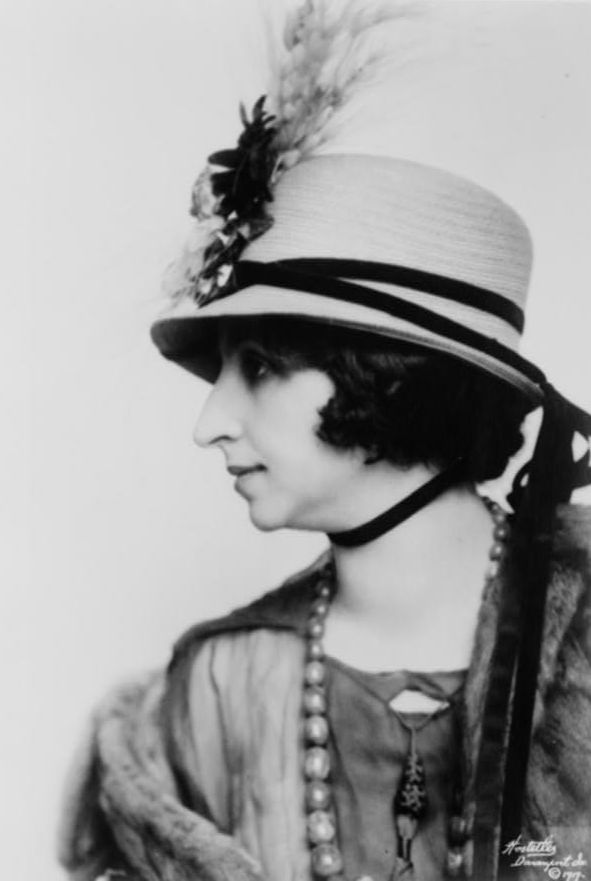
Amelita Galli-Curci |
Amelita Galli-Curci
“Singing is my need, my life. If I found myself on a desert island, I would sing there too … A person who has climbed a mountain range and does not see a peak higher than the one on which he is located has no future. I would never agree to be in his place. These words are not just a beautiful declaration, but a real program of action that guided the outstanding Italian singer Galli-Curci throughout her creative career.
“Every generation is usually ruled by one great coloratura singer. Our generation will choose Galli-Curci as their singing queen…” Dilpel said.
Amelita Galli-Curci was born on November 18, 1882 in Milan, in the family of a prosperous businessman Enrico Galli. The family encouraged the girl’s interest in music. This is understandable – after all, her grandfather was a conductor, and her grandmother once had a brilliant coloratura soprano. At the age of five, the girl began to play the piano. From the age of seven, Amelita regularly attends the opera house, which has become for her the source of the strongest impressions.
The girl who loved to sing dreamed of becoming famous as a singer, and her parents wanted to see Amelita as a pianist. She entered the Milan Conservatory, where she studied piano with Professor Vincenzo Appiani. In 1905, she graduated from the conservatory with a gold medal and soon became a fairly well-known piano teacher. However, after hearing the great pianist Ferruccio Busoni, Amelita realized with bitterness that she would never be able to achieve such mastery.
Her fate was decided by Pietro Mascagni, the author of the famous opera Rural Honor. Hearing how Amelita, accompanying herself on the piano, sings Elvira’s aria from Bellini’s opera “Puritanes”, the composer exclaimed: “Amelita! There are many excellent pianists, but how rare it is to hear a real singer!.. You play no better than hundreds of others… Your voice is a miracle! Yes, you will be a great artist. But not a pianist, no, a singer!”
And so it happened. After two years of self-study, Amelita’s skill was assessed by one opera conductor. After listening to her performance of the aria from the second act of Rigoletto, he recommended Galli to the director of the opera house in Trani, who was in Milan. So she got a debut in the theater of a small town. The first part – Gilda in “Rigoletto” – brought the young singer a resounding success and opened up to her other, more solid scenes in Italy. The role of Gilda has since forever become an adornment of her repertoire.
In April 1908, she was already in Rome – for the first time she performed on the stage of the Costanzi Theater. In the role of Bettina, the heroine of Bizet’s comic opera Don Procolio, Galli-Curci showed herself not only as an excellent singer, but also as a talented comic actress. By that time, the artist had married the artist L. Curci.
But in order to achieve real success, Amelita still had to undergo an “internship” abroad. The singer performed in the 1908/09 season in Egypt, and then in 1910 visited Argentina and Uruguay.
She returned to Italy as a well-known singer. Milan’s “Dal Verme” specifically invites her to the role of Gilda, and the Neapolitan “San Carlo” (1911) witnesses the high skill of Galli-Curci in “La Sonnambula”.
After another tour of the artist, in the summer of 1912, in South America (Argentina, Brazil, Uruguay, Chile), it was the turn of noisy successes in Turin, Rome. In the newspapers, recalling the singer’s previous performance here, they wrote: “Galli-Curci returned as a complete artist.”
In the 1913/14 season, the artist sings at the Real Madrid Theater. La sonnambula, Puritani, Rigoletto, The Barber of Seville bring her unprecedented success in the history of this opera house.
In February 1914, as part of the troupe of the Italian opera Galli-Curci, he arrived in St. Petersburg. In the capital of Russia, for the first time, she sings the parts of Juliet (Romeo and Juliet by Gounod) and Filina (Thomas’ Mignon). In both operas, her partner was L.V. Sobinov. Here is how the interpretation of the heroine of the opera Tom by the artist was described in the capital’s press: “Galli-Curci appeared to the charming Filina. Her beautiful voice, musicality and excellent technique gave her the opportunity to bring the part of Filina to the fore. She sang a polonaise brilliantly, the conclusion of which, at the unanimous demand of the public, she repeated, taking both times the three-point “fa”. On the stage, she leads the role smartly and freshly.”
But the crown of her Russian triumphs was La Traviata. The Novoye Vremya newspaper wrote: “Galli-Curci is one of the Violettas that St. Petersburg has not seen for a long time. She is impeccable both on stage and as a singer. She sang the aria of the first act with amazing virtuosity and, by the way, ended it with such a puzzling cadenza, which we have not heard from either Sembrich or Boronat: something stunning and at the same time dazzlingly beautiful. She was an outstanding success…”
Having reappeared in her native land, the singer sings with strong partners: the young brilliant tenor Tito Skipa and the famous baritone Titta Ruffo. In the summer of 1915, at the Colon Theater in Buenos Aires, she sings with the legendary Caruso in Lucia. “The extraordinary triumph of Galli-Curci and Caruso!”, “Galli-Curci was the heroine of the evening!”, “The rarest among singers” – this is how local critics regarded this event.
On November 18, 1916, Galli-Curci made her debut in Chicago. After “Caro note” the audience burst into an unprecedented fifteen-minute ovation. And in other performances – “Lucia”, “La Traviata”, “Romeo and Juliet” – the singer was received just as warmly. “Greatest Coloratura Singer Since Patti”, “Fabulous Voice” are just some of the headlines in American newspapers. Chicago was followed by a triumph in New York.
In the book “Vocal Parallels” by the famous singer Giacomo Lauri-Volpi we read: “To the writer of these lines, Galli-Curci was a friend and, in a way, godmother during his first performance of Rigoletto, which took place in early January 1923 on the stage of the Metropolitan Theater “. Later, the author sang with her more than once both in Rigoletto and in The Barber of Seville, Lucia, La Traviata, Massenet’s Manon. But the impression from the first performance remained for life. The singer’s voice is remembered as flying, surprisingly uniform in color, a little matte, but extremely gentle, inspiring peace. Not a single “childish” or bleached note. The phrase of the last act “There, in heaven, together with my dear mother …” was remembered as some kind of miracle of vocals – a flute sounded instead of a voice.
In the autumn of 1924, Galli-Curci performed in more than twenty English cities. The very first concert of the singer in the capital’s Albert Hall made an irresistible impression on the audience. “Magic charms of Galli-Curci”, “I came, sang – and won!”, “Galli-Curci conquered London!” – admiringly wrote the local press.
Galli-Curci did not bind herself with long-term contracts with any one opera house, preferring touring freedom. Only after 1924 did the singer give her final preference to the Metropolitan Opera. As a rule, opera stars (especially at that time) paid only secondary attention to the concert stage. For Galli-Curci, these were two completely equal spheres of artistic creativity. Moreover, over the years, concert activity even began to prevail over the theater stage. And after saying goodbye to opera in 1930, she continued to give concerts in many countries for several more years, and everywhere she was successful with the widest audience, because in its warehouse the art of Amelita Galli-Curci was distinguished by sincere simplicity, charm, clarity, captivating democracy.
“There is no indifferent audience, you make it yourself,” the singer said. At the same time, Galli-Curci never paid tribute to unpretentious tastes or bad fashion – the artist’s great successes were a triumph of artistic honesty and integrity.
With amazing relentlessness, she moves from one country to another, and her fame grows with every performance, with every concert. Her tour routes ran not only through major European countries and the United States. She was listened to in many cities in Asia, Africa, Australia and South America. She performed in the Pacific Islands, found time to record records.
“Her voice,” writes musicologist V.V. Timokhin, equally beautiful both in coloratura and in cantilena, like the sound of a magic silver flute, conquered with amazing tenderness and purity. From the very first phrases sung by the artist, listeners were fascinated by the moving and smooth sounds flowing with amazing ease… The perfectly even, plastic sound served the artist as a wonderful material for creating various, filigree-honed images…
… Galli-Curci as a coloratura singer, perhaps, did not know her equal.
The ideally even, plastic sound served the artist as a wonderful material for creating various filigreely honed images. No one has performed with such instrumental fluency the passages in the aria “Sempre libera” (“To be free, to be careless”) from “La Traviata”, in the arias of Dinora or Lucia and with such brilliance – the cadenzas in the same “Sempre libera” or in the “Waltz Juliet,” and that’s all without the slightest tension (even the highest notes did not produce the impression of extremely high ones), which could give the listeners the technical difficulties of the sung number.
The art of Galli-Curci made contemporaries recall the great virtuosos of the 1914th century and say that even the composers who worked in the era of the “golden age” of bel canto could hardly imagine a better interpreter of their works. “If Bellini himself had heard such an amazing singer as Galli-Curci, he would have applauded her endlessly,” wrote the Barcelona newspaper El Progreso in XNUMX after the performances of La sonnambula and Puritani. This review of the Spanish critics, who mercilessly “cracked down” on many luminaries of the vocal world, is quite indicative. “Galli-Curci is as close to complete perfection as possible,” admitted two years later the famous American prima donna Geraldine Farrar (an excellent performer of the roles of Gilda, Juliet and Mimi), after listening to Lucia di Lammermoor at the Chicago Opera.
The singer was distinguished by an extensive repertoire. Although it was based on Italian opera music – works by Bellini, Rossini, Donizetti, Verdi, Leoncavallo, Puccini – it also performed brilliantly in operas by French composers – Meyerbeer, Bizet, Gounod, Thomas, Massenet, Delibes. To this we must add the superbly performed roles of Sophie in R. Strauss’s Der Rosenkavalier and the role of the Queen of Shemakhan in Rimsky-Korsakov’s The Golden Cockerel.
“The role of the queen,” the artist noted, “takes no more than half an hour, but what a half hour it is! In such a short period of time, the singer faces all sorts of vocal difficulties, among other things, such that even the old composers would not have come up with.
In the spring and summer of 1935, the singer toured India, Burma and Japan. Those were the last countries where she sang. Galli-Curci temporarily withdraws from concert activity due to a serious throat disease that required surgical intervention.
In the summer of 1936, after intense studies, the singer returned not only to the concert stage, but also to the opera stage. But she didn’t last long. The final appearances of Galli-Curci took place in the 1937/38 season. After that, she finally retires and retires to her home in La Jolla (California).
The singer died on November 26, 1963.





